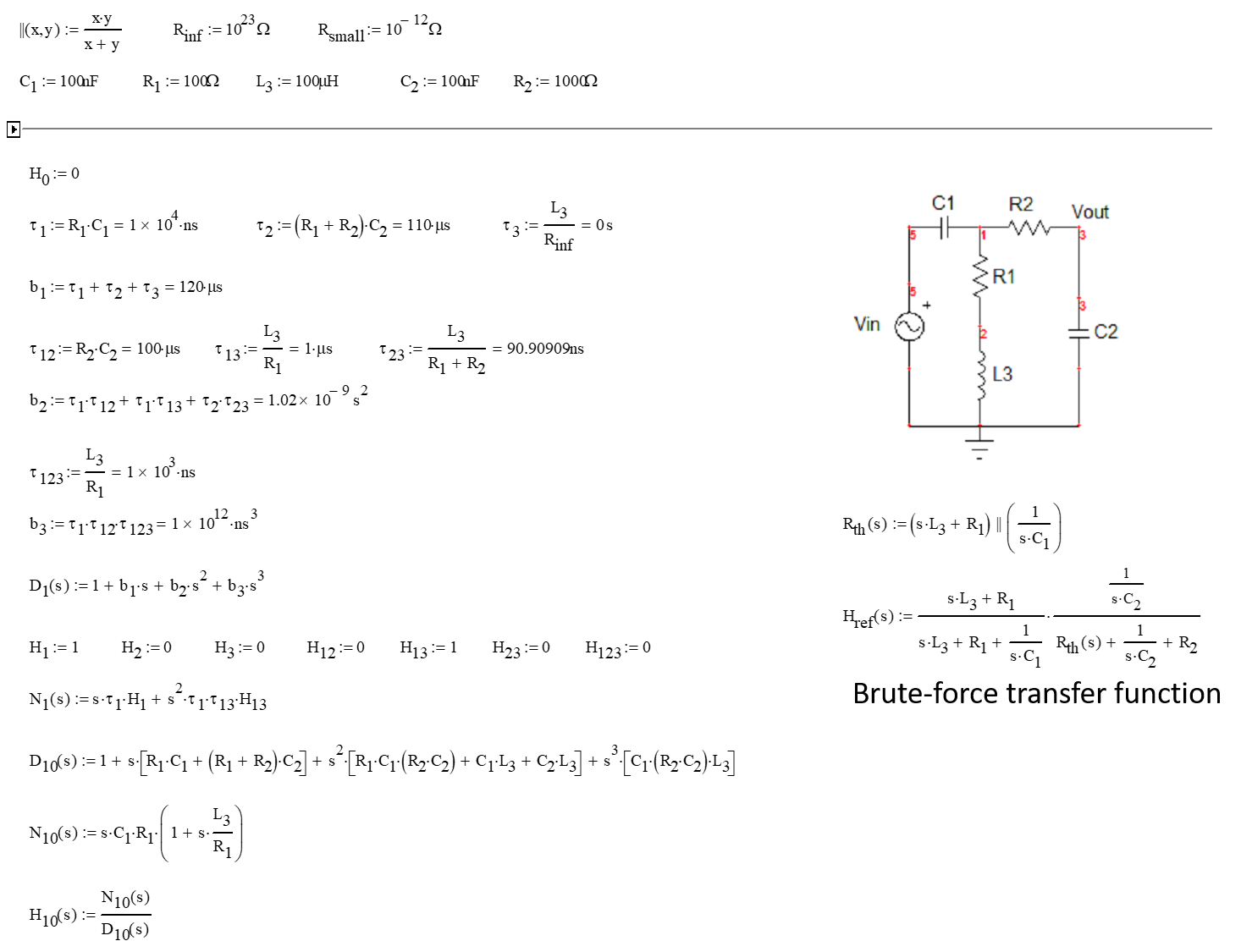Have I obtained the correct simplified transfer function for this RLC circuit?
I am trying to obtain the transfer function for the following RCL circuit. However, the response of the TF that I obtain doesn't correlate to the response of the circuit itself when I simulate it. Please see below:
Therefore, I have obviously done something wrong. I have spent a good couples of days and plenty of scrap papers trying to see where I have missed something, but I keep on arriving at the same answer.
So, in order to save myself the headache of repeatedly doing the same thing only to obtain the same outcome, I've decided to put my dilemma to the community!
Below is my working out from the mid-way point to the end result and if anyone can spot or point out what I have missed, I would really appreciate it.
So the starting expression is:
$$ I_2(s)((\frac{C_2Ls^3+C_2(R_1+R_2)s+1}{C_2Ls^2+C_2R_1s})(\frac{C_1Ls^2+C_1R_1s+1}{C_1s}))-I_2(s)(Ls+R_1)=E_i(s)\tag{1} $$
$$ I_2(s)((\frac{C_2Ls^3+C_2(R_1+R_2)s+1}{C_2Ls^2+C_2R_1s})(\frac{C_1Ls^2+C_1R_1s+1}{C_1s})-(Ls+R_1))=E_i(s) $$
$$ I_2(s)(\frac{(C_2Ls^2+C_2(R_1+R_2)s+1)({C_1Ls^2+C_1R_1s+1})}{(C_2Ls^2+C_2R_1s)(C_1s)})-(Ls+R_1))=E_i(s) $$
$$ I_2(s)(\frac{(C_2Ls^2+C_2(R_1+R_2)s+1)(C_1Ls^2+C_1R_1s+1)-(C_1C_2Ls^3+C_1C_2R_1s^2)(Ls+R_1)}{(C_1C_2Ls^3+C_1C_2R_1s^2)})\tag{2}$$
Expanding the numerator for the positive term
$$ (C_2Ls^2+C_2(R1+R2)s+1)(C_1Ls^2+C_1R_1s+1)$$
$$ (C_2Ls^2)(C_1Ls^2) + (C_2Ls^2)(C_1R_1s) + (C_2Ls^2)(1) + (C_2(R_1+R_2)s)(C_1Ls^2) + (C_2(R_1+R_2)s)(C_1R_1s)+(C_2(R_1+R_2)s)(1)) + (1)(C_1Ls^2) + (1)(C_1R_1s) + (1)(1) $$
$$ (C_1C_2L^2s^4) + (C_1C_2R_1Ls^3) + (C_2Ls^2) + (C_1C_2L(R_1+R_2)s^3) + (C_1C_2R_1(R_1+R_2)s^2) + C_2(R_1+R_2)s + (C_1Ls^2) + (C_1R_1s) + 1 $$
$$ C_1C_2L^2s^4 + C_1C_2R_1Ls^3 + C_2Ls^2 + C_1C_2L(R_1+R_2)s^3 + C_1C_2R_1(R_1+R_2)s^2 + C_2(R_1+R_2)s + C_1Ls^2 + C_1R_1s + 1 $$
$$ C_1C_2L^2s^4 + C_1C_2R_1Ls^3 + C_2Ls^2 + C_1C_2R_1Ls^3 + C_1C_2R_2Ls^3 + C_1C_2R_1^2s^2 + C_1C_2R_1R_2s^2 + C_2(R_1+R_2)s + C_1Ls^2 + C_1R_1s + 1 $$
$$ C_1C_2L^2s^4 + 2C_1C_2R_1Ls^3 + C_2Ls^2 + C_1C_2R_2Ls^3 + C_1C_2R_1^2s^2 + C_1C_2R_1R_2s^2 + C_2(R_1+R_2)s + C_1Ls^2 + C_1R_1s + 1 \tag{3}$$
Expanding the numerator for the negative term
$$ -(C_1C_2Ls^3+C_1C_2R_1s^2)(Ls+R_1)$$
$$ -((C_1C_2Ls^3)(Ls)+(C_1C_2Ls^3)(R_1)+(C_1C_2R_1s^2)(Ls)+(C_1C_2R_1s^2)(R_1))$$
$$ -(C_1C_2L^2s^4 + C_1C_2R_1Ls^3 + C_1C_2R_1Ls^3 + C_1C_2R_1^2s^2)\tag{4}$$
Subtracting \$(4)\$ from \$(3)\$
$$ C_1C_2L^2s^4 + 2C_1C_2R_1Ls^3 + C_2Ls^2 + C_1C_2R_2Ls^3 + C_1C_2R_1^2s^2 + C_1C_2R_1R_2s^2 + C_2(R_1+R_2)s + C_1Ls^2 + C_1R_1s + 1 -C_1C_2L^2s^4 - C_1C_2R_1Ls^3 - C_1C_2R_1Ls^3 - C_1C_2R_1^2s^2 $$
$$ C_1C_2L^2s^4 + 2C_1C_2R_1Ls^3 + C_2Ls^2 + C_1C_2R_2Ls^3 + C_1C_2R_1^2s^2 + C_1C_2R_1R_2s^2 + C_2(R_1+R_2)s + C_1Ls^2 + C_1R_1s + 1 - C_1C_2L^2s^4 - 2C_1C_2R_1Ls^3 - C_1C_2R_1^2s^2 $$
$$ C_2Ls^2 + C_1C_2R_2Ls^3 + C_1C_2R_1R_2s^2 + C_2(R_1+R_2)s + C_1Ls^2 + C_1R_1s + 1 $$
Combining like terms
$$ C_1C_2R_2Ls^3 + (C_1(C_2R_1R_2 + L)+ C_2L)s^2 + (C_2(R_1+R_2) + C_1R_1)s + 1 $$
Therefore, I get
$$ I_2(s)\frac{C_1C_2R_2Ls^3 + (C_1(C_2R_1R_2 + L)+ C_2L)s^2 + (C_2(R_1+R_2) + C_1R_1)s + 1}{C_1C_2Ls^3+C_1C_2R_1s^2} = E_i(s)$$
And I arrive at this final transfer function each and every time:
$$ \frac{I_2(s)}{E_i(s)}=\frac{C_1C_2Ls^3+C_1C_2R_1s^2}{C_1C_2R_2Ls^3 + (C_1(C_2R_1R_2 + L)+ C_2L)s^2 + (C_2(R_1+R_2) + C_1R_1)s + 1} \tag{5}$$
Therefore, if anyone has noted any step(s) that I might have missed, I would really appreciate it, if you could please point it out :)








